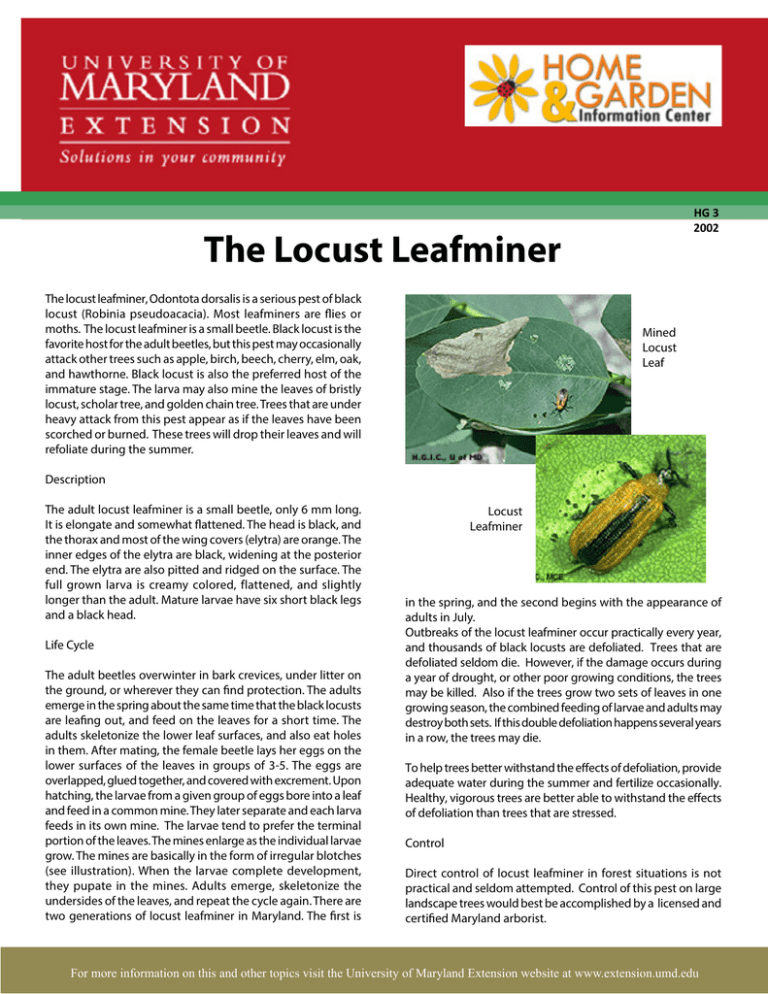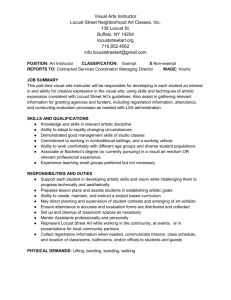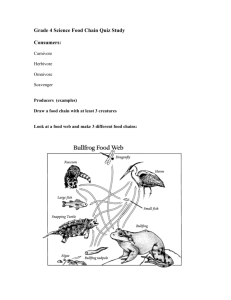The Locust Leafminer
advertisement

HG 3 2002 The Locust Leafminer The locust leafminer, Odontota dorsalis is a serious pest of black locust (Robinia pseudoacacia). Most leafminers are flies or moths. The locust leafminer is a small beetle. Black locust is the favorite host for the adult beetles, but this pest may occasionally attack other trees such as apple, birch, beech, cherry, elm, oak, and hawthorne. Black locust is also the preferred host of the immature stage. The larva may also mine the leaves of bristly locust, scholar tree, and golden chain tree. Trees that are under heavy attack from this pest appear as if the leaves have been scorched or burned. These trees will drop their leaves and will refoliate during the summer. Mined Locust Leaf Description The adult locust leafminer is a small beetle, only 6 mm long. It is elongate and somewhat flattened. The head is black, and the thorax and most of the wing covers (elytra) are orange. The inner edges of the elytra are black, widening at the posterior end. The elytra are also pitted and ridged on the surface. The full grown larva is creamy colored, flattened, and slightly longer than the adult. Mature larvae have six short black legs and a black head. Life Cycle The adult beetles overwinter in bark crevices, under litter on the ground, or wherever they can find protection. The adults emerge in the spring about the same time that the black locusts are leafing out, and feed on the leaves for a short time. The adults skeletonize the lower leaf surfaces, and also eat holes in them. After mating, the female beetle lays her eggs on the lower surfaces of the leaves in groups of 3-5. The eggs are overlapped, glued together, and covered with excrement. Upon hatching, the larvae from a given group of eggs bore into a leaf and feed in a common mine. They later separate and each larva feeds in its own mine. The larvae tend to prefer the terminal portion of the leaves. The mines enlarge as the individual larvae grow. The mines are basically in the form of irregular blotches (see illustration). When the larvae complete development, they pupate in the mines. Adults emerge, skeletonize the undersides of the leaves, and repeat the cycle again. There are two generations of locust leafminer in Maryland. The first is Locust Leafminer in the spring, and the second begins with the appearance of adults in July. Outbreaks of the locust leafminer occur practically every year, and thousands of black locusts are defoliated. Trees that are defoliated seldom die. However, if the damage occurs during a year of drought, or other poor growing conditions, the trees may be killed. Also if the trees grow two sets of leaves in one growing season, the combined feeding of larvae and adults may destroy both sets. If this double defoliation happens several years in a row, the trees may die. To help trees better withstand the effects of defoliation, provide adequate water during the summer and fertilize occasionally. Healthy, vigorous trees are better able to withstand the effects of defoliation than trees that are stressed. Control Direct control of locust leafminer in forest situations is not practical and seldom attempted. Control of this pest on large landscape trees would best be accomplished by a licensed and certified Maryland arborist. 1 For more information on this and other topics visit the University of Maryland Extension website at www.extension.umd.edu USE INSECTIDES WITH CARE. READ THE LABEL DIRECTIONS. FOLLOW ALL SAFETY PRECAUTIONS. Mention of trade names in this publication does not constitute an endorsement by Universitiy of Maryland Extension. Do you have a plant or insect pest question? Visit us at extension.umd.edu/hgic and click Ask Maryland’s Garden Experts Author: Mary Kay Malinoski, University of Maryland Extension Specialist, Home and Garden Information Center This publication is a series of publications of the University of Maryland Extension and The Home and Garden Information Center. For more information on related publications and programs, http://extension.umd.edu/hgic. Please visit http://extension.umd.edu/ to find out more about Extension programs in Maryland. The University of Maryland, College of Agriculture and Natural Resources programs are open to all and will not discriminate against anyone because of race, age, sex, color, sexual orientation, physical or mental disability, religion, ancestry, or national origin, marital status, genetic information, or political affiliation, or gender identity and expression. 2 For more information on this and other topics visit the University of Maryland Extension website at http://extension.umd.edu



